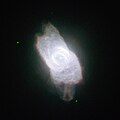Файл:NGC 6572.jpg
Перейти к навигации
Перейти к поиску
NGC_6572.jpg (500 × 500 пкс, размер файла: 135 КБ, MIME-тип: image/jpeg)
История файла
Нажмите на дату/время, чтобы посмотреть файл, который был загружен в тот момент.
| Дата/время | Миниатюра | Размеры | Участник | Примечание | |
|---|---|---|---|---|---|
| текущий | 17:08, 14 декабря 2010 |  | 500 × 500 (135 КБ) | Antonsusi | Better jpg-quality, less environment of no interest |
| 14:59, 13 декабря 2010 |  | 629 × 638 (68 КБ) | Jmencisom | {{Information |Description={{en|1=The NASA/ESA Hubble Space Telescope has turned its eagle eye to the planetary nebula NGC 6572, a very bright example of these strange but beautiful objects. Planetary nebulae are created during the late stages of the evol |
Использование файла
Следующие 3 страницы используют этот файл:
Глобальное использование файла
Данный файл используется в следующих вики:
- Использование в ar.wikipedia.org
- Использование в az.wikipedia.org
- Использование в be.wikipedia.org
- Использование в ce.wikipedia.org
- Использование в cs.wikipedia.org
- Использование в de.wikipedia.org
- Использование в diq.wikipedia.org
- Использование в en.wikipedia.org
- Использование в fa.wikipedia.org
- Использование в fr.wikipedia.org
- Использование в hr.wikipedia.org
- Использование в it.wikipedia.org
- Использование в it.wikibooks.org
- Использование в kk.wikipedia.org
- Использование в mk.wikipedia.org
- Использование в nl.wikipedia.org
- Использование в pl.wikipedia.org
- Использование в pt.wikipedia.org
- Использование в sk.wikipedia.org
- Использование в tr.wikipedia.org
- Использование в tt.wikipedia.org
- Использование в www.wikidata.org
- Использование в zh.wikipedia.org
